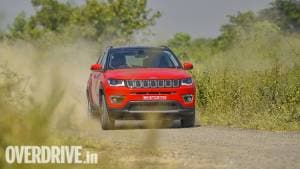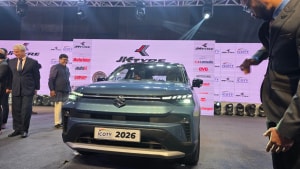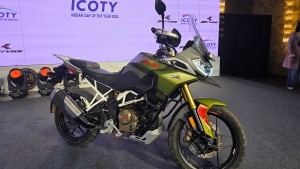Comparison: 2017 Jeep Compass vs Hyundai Tucson vs Tata Hexa
As far as stereotypes go, Americans like their SUVs like they like their burgers extra large! So then for Jeep, a company that's as American as McDonald's, to make a compact SUV like the Compass seems a bit odd, doesn't it? That's because the Compass isn't really for the American market. It's aimed at developing markets like India where we like big SUVs, but we also like them to be practical, premium and affordable all at the same time. Tough crowd, huh? Well, the Jeep Compass aims to tick all those boxes, and we wanted to see how it fares against its competition.
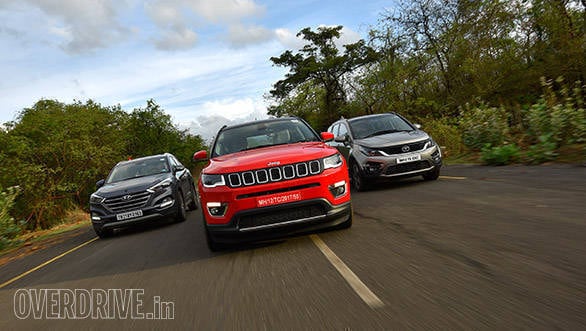
Now the only problem with that is that Jeep hasn't given us anything about the price except for an estimate - Rs 15-20 lakh (ex-showroom). That's a tricky spot because it falls right in between the affordable 7-seater SUVs like the Tata Hexa and the more expensive premium crossovers like the Hyundai Tucson. So which one do we compare it with? Well, why not both! Does the Compass manage to find solid middle ground between practicality and luxury? Time to hit the road!
Exterior design
All three cars have a very different appeal about them. The Tata Hexa is the meanest-looking car here just by virtue of being the largest. It dwarfs the other two cars in every dimension and it does so without looking like an elephant. The Hexa is a pretty good-looking car from the outside with the theme being 'extra large'. Everything from the headlights to the ORVMs and the wheels are quite large, but without looking out of proportion. All that cladding, the smoke-finished headlights and the 19-inch wheels add a lot of character and I really like that. Admittedly, it does look a little MPV-ish from the side and rear, but a premium-looking one at that.
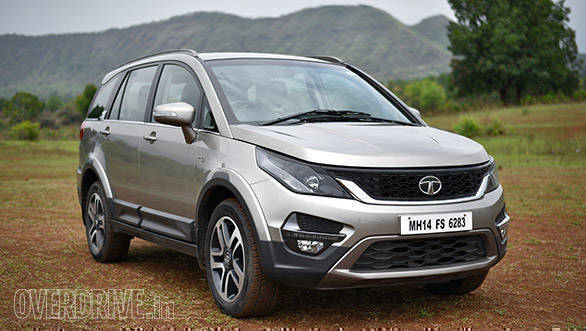
But the Hyundai Tucson manages to look far more sophisticated with the smooth lines and curves flowing all around. The front, although not imposing, looks very smart thanks to the sleek, swept-back headlights that integrate with the grille. The hexagonal fog lamp/DRL enclosure and the optimal use of chrome ensure that it doesn't look overdone. But from the side and rear, the Tucson looks more crossover than SUV. It's a clever design, with an upward-sloping window-line and crease which make it seem like it has a sporty, downward sloping roof instead. And those multi-spoke wheels only add to the sporty and premium nature of the car. The rear does look a little like a hopped-up Elite i20, but it doesn't look bad at all, especially with the twin exhaust tips.
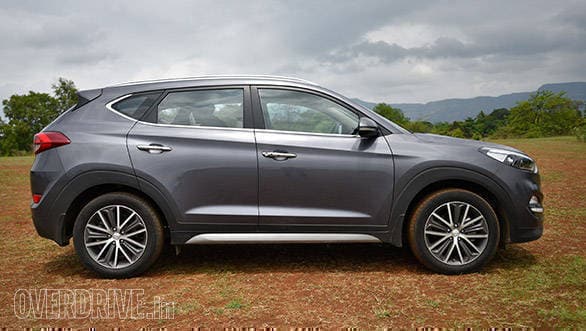
But if I had to pick one as my favourite, it would be the Jeep Compass, and I'm not just saying that because it's the newest car here. It offers a good balance between sophisticated and imposing. Yes, it looks like a smaller Grand Cherokee, but that's certainly a good thing! While it's not actually that large when you stand next to it, the large bumper with the narrow seven-slat grille and sleek headlights make it look quite imposing in a car's rear-view mirror. From the side, it still looks quite broad and muscular with its strong character lines and the flared, square-ish wheel arches.
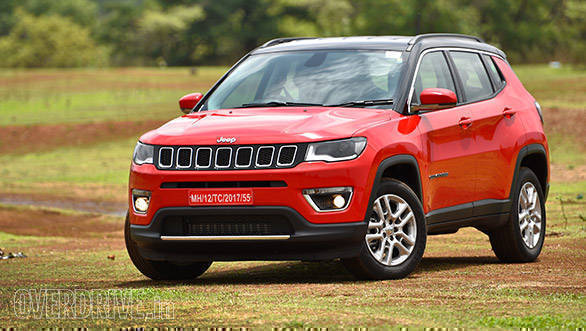
Admittedly, the 225/60 R17 wheels look a little small for the car, and the rear wheel isn't at the centre of the arch. The last bit especially bugs me, because once you've seen it, that's the first thing you'll notice every time you look at the car. Yep, it's too late! You can't un-see it now! But thankfully, the rear end of the Compass manages to draw your eyes away. It looks quite smart, thanks to the neat LED elements in the tail lights and the chrome strip which runs all around the car, visually separating the roof from the rest of the car.
Interior and build quality
For me, the Hyundai Tucson comes out on top in terms of how the interior is designed and built. The dashboard looks like a grown-up, more premium version of the Hyundai Creta's, and some might find that a little repetitive. But there's no denying its excellent build quality, premium feel and ergonomic design. The light colours make the dash feel airy and the space has been utilised quite well to offer sufficient storage. The overall design is very simple, with large easy-to-read and easy-to-operate buttons that you'll never fumble over. Additionally, the seats are very comfortable over long distances with good bolstering and support.
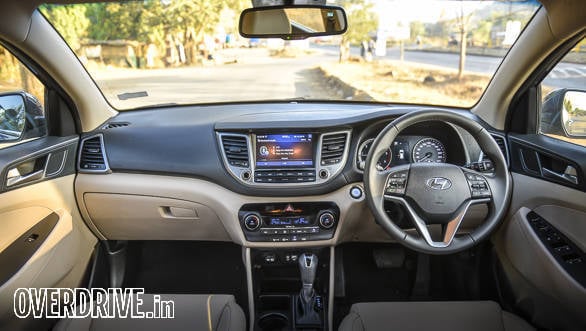
The Jeep Compass comes in at a close second here. After the Tucson, the cabin feels a little small, but the dashboard design is far from boring. The build quality is impressive for the most part, with just a few bits and pieces getting hard plastics. The chunky steering wheel looks great and feels just as good to hold. However, the dummy buttons where the cruise control switches would have gone look quite odd. The instrument cluster, on the other hand, gets large dials and a very informative display unit which can be customised to show the information you want. And while white might not be the best colour for upholstery in India, it certainly does make the interior look quite luxurious.
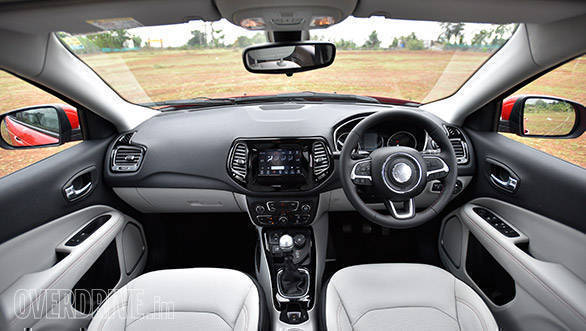
However, I did find the lack of storage spaces in the Compass a little disappointing - even the door pockets are pretty small. The centre console isn't the most ergonomic either. The controls for the aircon and infotainment system are all bunched up together and that can be a bit confusing initially. It would have been nice if the empty space below the touchscreen housed some of the controls to clear up the clutter.
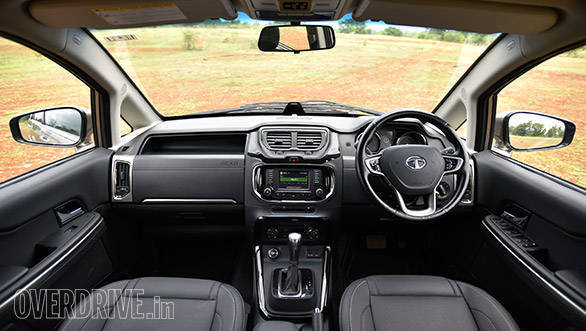
In comparison, the Tata Hexa's dashboard feels well spaced-out, and you won't find yourself fumbling to find a particular switch. The overall design is quite likeable and there are a few premium-looking bits like the faux brushed-aluminium finish around the side AC vents and the piano black trims around the central AC vents and infotainment system. There are a decent number of few storage spaces everywhere except below the centre console where there appears to be quite a bit of empty space. While the overall cabin of the Hexa looks and feels good, there are certain cheap, flimsy plastic bits like the door locks and seat adjustment levers that feel like they'd break at any second.
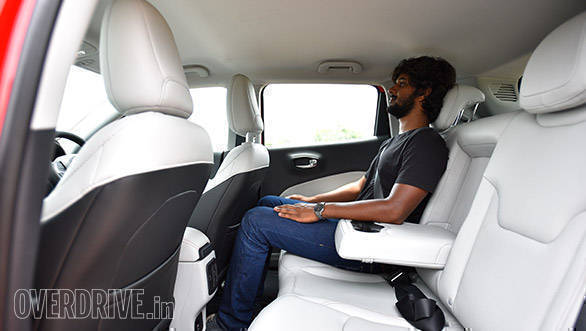
Where the Hexa does come out on top is in terms of cabin space. While kneeroom is (surprisingly) almost identical in the three cars, the Hexa does come with third-row seats and the optional second-row captain seats. If you opt for the single second-row seat, you'll even get more shoulder room than in the other cars. The Tucson stands at second with around 3cm more shoulder room than the Compass. But that's not to say that the Compass is crammed - there's sufficient kneeroom and shoulder room to seat three passengers comfortably at the back.
Engine, performance and efficiency
The Jeep Compass will be offered with two engines, and the one we've driven debuts the 2.0-litre Multijet II diesel engine in India. It produces 173PS at 3,750rpm and 350Nm from 1,750-2,500rpm and gets a 6-speed manual transmission while an automatic option will be on offer later in the year. The other engine that will be offered is a 1.4-litre Multiair turbo-petrol engine which will be offered with the choice of a 6-speed manual and a 6-speed dual-clutch transmission. Both engines will be offered in 4x4 and 4x2 variants, but the 4x4 system is not like your conventional SUV's unit. The Jeep Compass is primarily a front-wheel-driven car with power sent to the rear whenever needed or when the 4x4 lock is engaged. It gets four modes - Auto, Snow, Sand and Mud - but we didn't really get the chance to test its off-road capabilities.
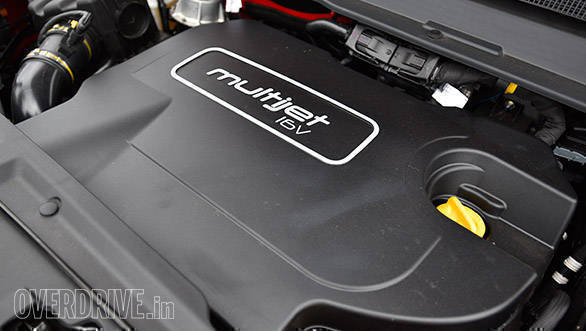
The Multijet II engine still retains the basic nature of the first-gen Multijet engines - a relatively slow-revving engine with some amount of turbo lag till around 1,800rpm, and then a gush of power almost all the way to the redline. However, unlike the older version, the power isn't just shoved in your face all at once - it is very smooth, just like the engine itself. While the motor is pretty loud from the outside, most of it is dulled out in the cabin. It isn't as quiet or as refined as the Tucson's diesel engine, but it doesn't sound loud and clatter-y either. But the real highlight is the Compass's gearbox. The gear shifts aren't slick but feel very precise and a little mechanical - both of which feel great while changing gears. And that perfect, large, round gear knob looks great and feels even better in your hand!
Although there is lag below the 1,800rpm mark, it doesn't stutter or stall even in third gear at around 20kmph. And as long as you keep the engine in its powerband, there's strong pull that holds right up to the 4,500rpm redline. We managed a 0-100kmph time of 11.9 seconds, which is around 2.6 seconds slower than the Tucson, and half a second quicker than the Hexa.
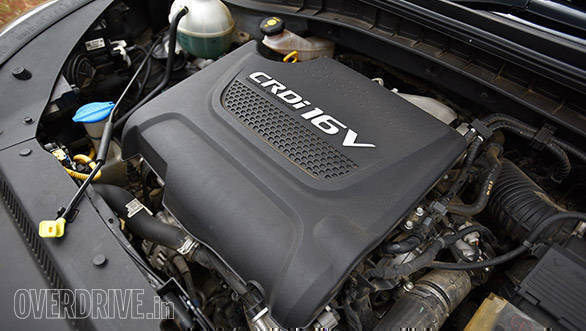
But we're not surprised that the Hyundai Tucson was quicker - it makes over 10PS and 50Nm more. The variant we've got here gets a 2.0-litre turbo-diesel engine which produces 185PS at 4,000rpm and 400Nm from 1,750-2,750rpm. It is offered with two gear boxes - a 6-speed automatic, like the one in this test, and a 6-speed manual. The Tucson can also be had with a 2.0-litre petrol engine that makes 155PS and 192Nm - again with the option of a 6-speed auto or manual. But for this test, we're going to focus on the diesel variant with the 6-speed auto.
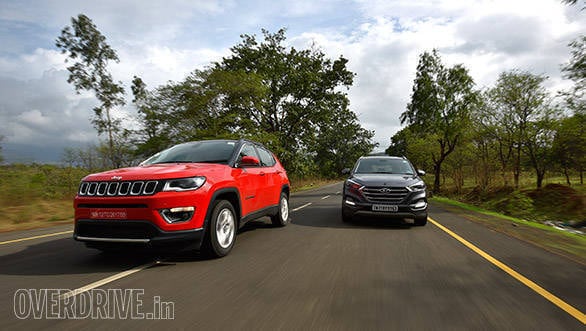
The Tucson definitely has the smoothest diesel unit here - not as refined as the other diesel engines from Hyundai, but refined nonetheless. There's hardly any lag and the engine is bit more free-revving and responsive than the Compass's Multijet II. The 6-speed auto, meanwhile, offers smooth shifts that go hand in hand with the creamy nature of the engine. That said, it's not the quickest gearbox in the market. While it is responsive to throttle inputs, the gearshifts itself feel slow and that can be a bit of a bother during quick overtakes.
Another downside is that it doesn't come with a four-wheel-drive variant in India like the Compass. Not that a lot of the Indian consumers need it, but at least Jeep is giving us that option. What the Tucson does gets though are three drive modes which adjust gearshifts, engine and throttle settings - Normal, Sport and Eco. With the Eco mode on, it managed to be the most efficient car in this test, returning 12.25kmpl in the city and 16.71kmpl on the highway. In comparison, the Compass returned 11.39kmpl in the city and 14.11kmpl on the highway. The Hexa was the least efficient here with an average of 10.54kmpl in the city and 12.7kmpl on the highway.
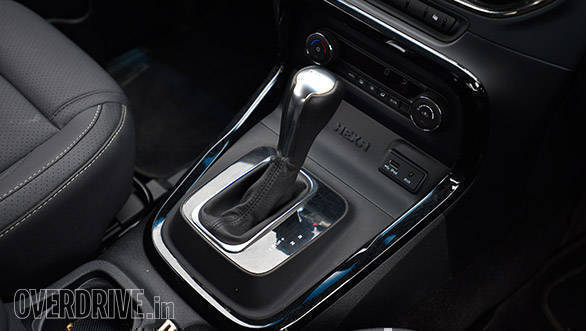
This, of course, was the Tata Hexa with a 6-speed automatic transmission. The manual variant, which isn't part of this test, gets a 6-speed manual and returned a significantly better 13.2kmpl in the city and 17.2kmpl on the highway. Both variants use a 2.2-litre turbo-diesel that produces 156PS at 4,000rpm and 400Nm from 1,700-2,700rpm which is fairly quiet inside the cabin. It's certainly not the most rev-happy engine over here, but instead feels a bit old-school. There is a fair amount of lag till around 1,700rpm after which power delivery is quite smooth and linear. However, if you were driving the manual Hexa, you'd have to constantly work the gearbox to extract any sort of performance out of the engine. The automatic, on the other hand, takes care of all the constant shifting and is a much better car to drive. While it does get a Sport mode, it doesn't get four-wheel drive like the manual variant, and therefore none of the other drive modes - Auto, Rough Road and Comfort.
Ride and handling
When it comes to ride quality, the Tata Hexa is the undefeated champion. It irons out every bump, rut, pothole and rumble strip effortlessly, and barely transfers any of the impact to the cabin. The high-seating position and the large tyres make you feel like you're king of the road even when there is no road left. It feels like a typical old-school SUV too, with its body-on-frame chassis set-up, but handles like one too.
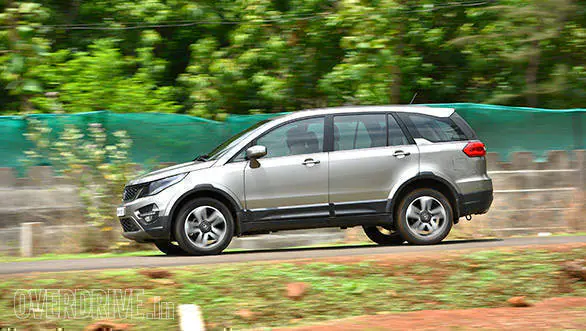
The Hexa is not a very nimble SUV and isn't too happy, making quick direction changes because of the amount of body roll. There isn't a terrifying amount of roll, but it's certainly not confidence inspiring. The steering, meanwhile, offers a good amount of feedback and is well-weighted at high speeds, helping keep the car stable even at around 140kmph. But that's because the steering is generally quite heavy to use, especially in the city.
In comparison, the Hyundai Tucson's steering is very comfortable at all speeds and all conditions. The electric steering is still not the liveliest one out there, but it's far better than the previous Hyundais. The Tucson is not the most involving car to drive up a winding road, but it does get the job done. The suspension is a bit on the softer side, and that makes it feel a bit squishy around the corners. But the little bit of body roll is well controlled and not in the least bit unnerving.
It isn't as comfortable as the Hexa over broken roads, but the Tucson's suspension is quiet, supple and absorbs all but the large potholes and bumps very well. However, it doesn't have that indestructible feel you get with the Hexa. It feels more crossover than SUV, albeit a very comfortable crossover.
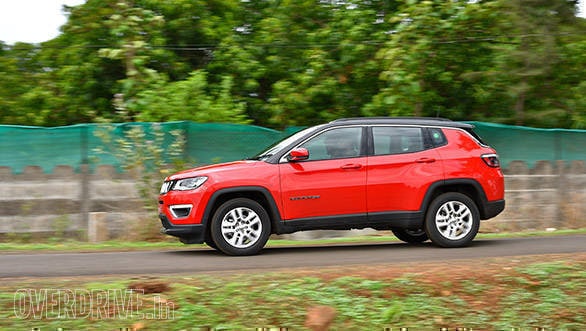
The Jeep Compass manages to bring in a little bit of both - comfort and ruggedness. It uses a MacPherson strut set-up and an independent Chapman strut set-up at the rear, along with Koni's frequency sensitive dampers. These dampers use hydraulic valves to control how much damping happens, depending on the frequency of suspension movement - high frequency (while driving over bad roads) will reduce damping for better ride quality, while low frequency (on smooth roads) will increase damping for better stability and handling. This system does the same function as adjustable dampers without all the expensive and complicated electrical systems.
And what's the result of all this tech? A very involving car to drive that's also very comfortable! The Compass is not only the best-handling SUV in this test, but possibly, in this price bracket! It stays surprisingly flat through corners even when you push it hard, and to make it better, the OEM Firestone tyres never squeal! The steering feels direct and weighs up well at high speeds, and for an electrically assisted unit, there is plenty of feedback.
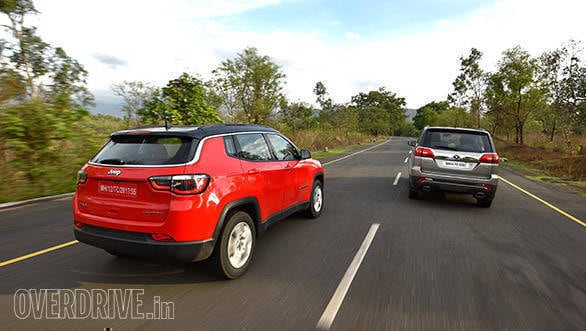
Over bad roads, the Compass happily absorbs the impact quietly and feels almost as rugged as the Hexa. There is more movement at the rear seat than in the Tucson, but it's certainly not a deal-breaker. High-speed stability is another stronghold, and just like the Hyundai, it'll sit at pretty high triple-digit speeds without breaking a sweat.
Safety and features
With respect to standard safety features, the Jeep Compass has the edge. While all three cars get ABS and front airbags as standard, only the Compass gets electronic stability control (ESC) and hill-start assist too. In the top-end variant, the Compass gets eight airbags, traction control, cornering lights and adaptive brake lights (they flash in case of emergency braking).
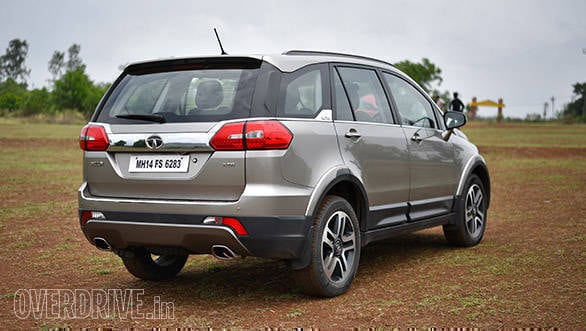
The top-end variant of the Hyundai Tucson gets six airbags, ESC, traction control, hill-start assist and hill descent control. The Tata Hexa meanwhile, gets six airbags, hill-start assist, ESP and traction control, and hill-descent control (the last three features are available only in the manual) in the top-spec variant. However, unlike the other two cars, it doesn't get ISOFIX mounts for child seats or a three-point seatbelt for the passenger sitting in the middle of the second row seat.
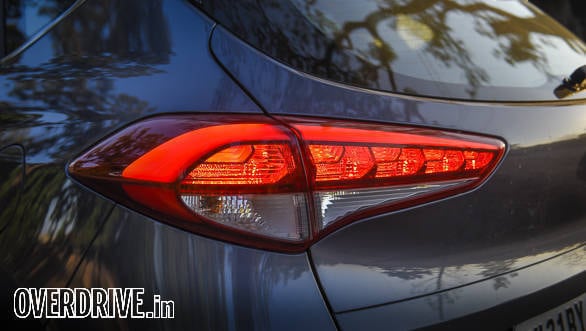
In terms of creature comforts, the Tucson tops the charts. It gets dual LED headlights, an electric tailgate, dual-zone climate control, electrically adjustable driver's seat, keyless entry and ignition, heated ORVMs, automatic headlamps, cruise control and an 8-inch touchscreen display that supports Android Auto and Apple CarPlay.
The Hexa comes in at second with a few more features than the Compass. You get four auto-down windows, cruise control, auto headlamps, automatic wipers, heated ORVM a very good 10-speaker JBL sound system but a not-so-good Harman touchscreen system.
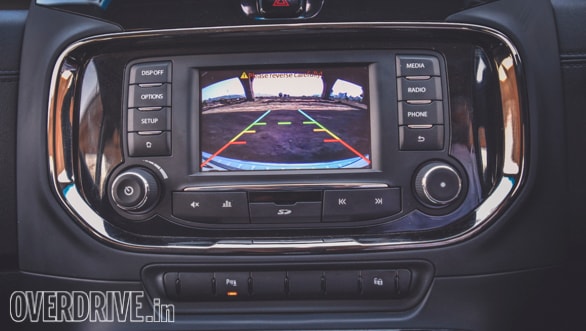
The Compass isn't the best specced here, but you do get some nice features like dual-zone climate control, bi-xenon headlamps, auto up/down front windows, a decent 7-inch touchscreen infotainment system and keyless entry and ignition. But you miss features like auto headlamps and cruise control which you see in cars positioned lower than it.
Verdict
At the end of this comparison, the Tata Hexa still remains the most value-for-money car you can buy in the price range. For Rs 17.40 (ex-Delhi) you get a lot of space, excellent ride quality, a good number of features and even a 4x4 option if you're okay with the manual (Rs 17.49 lakh). It's certainly the more practical car here, but it somehow lacks the premium appeal, which a lot of customers care about.
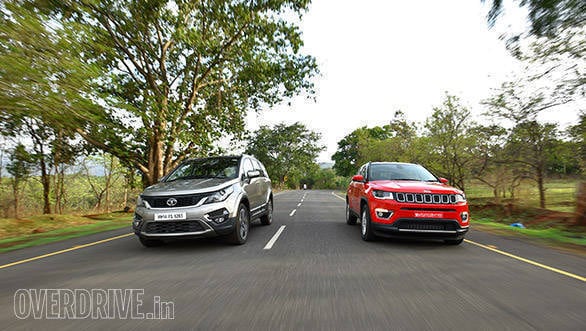
So if that is your primary concern, the Hyundai Tucson is the car for you. It costs a hefty Rs 25.01 lakh, but you get a whole lot of features, excellent performance, good efficiency, and comfort and, most importantly, a car that can hold its own against the entry-level luxury crossovers from Germany. However, it lacks the ruggedness or feel of a big, bad SUV, and doesn't come with a four-wheel-drive variant.
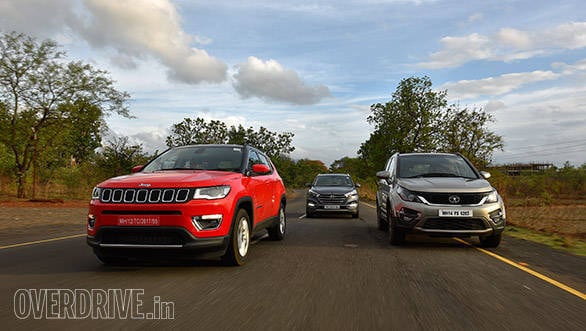
So then that brings us to middle ground the Jeep Compass. It might not have the best set of features here, but it comes with good safety kit, excellent ride and handling, a premium design, the typical rugged SUV feel and 4×4. But my favourite bit about the Compass is that it's a driver-focussed car something this segment has been lacking for a while now. And it manages all of this without compromising too much on practicality, luxury or price. If it's what we think that's gonna be, the top-spec manual will be priced at around Rs 20 lakh (Ex-Delhi). If Jeep manages to stick to this pricing, the Compass will be in a class apart. If it can't, and the prices go any higher, it will struggle to keep its head out of the water because it is neither as premium as the Tucson nor as practical as the Hexa. Any higher than our estimate, and the Compass will lose its middle ground advantage.
Here's our comparison video review:
Starts Rs 17.79 Lakhs
1956cc
Automatic
163
350
14.9 Kmpl
Starts Rs 27.69 Lakhs
1997cc
Automatic
156
416
12.95 Kmpl
Starts Rs 9.99 Lakhs
1353cc
Automatic
115
242
-NA-
-NA-
2179cc
Manual
-NA-
400
-NA-

